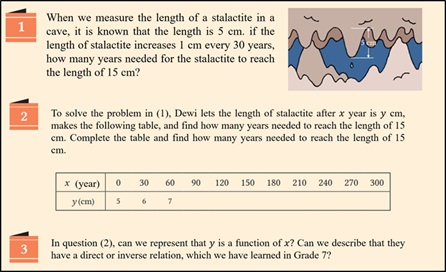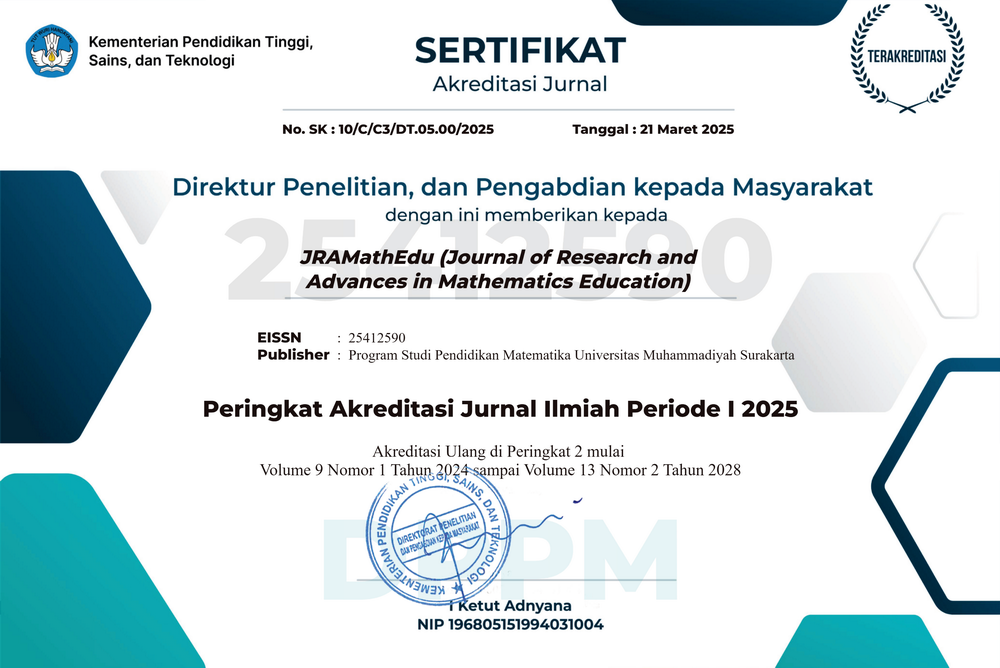An analysis of mathematics textbook of Indonesian curriculum based on functional thinking framework
DOI:
https://doi.org/10.23917/jramathedu.v8i4.1928Keywords:
Kurikulum Merdeka, Mathematics Textbook, Functional Thinking, AlgebraAbstract
Functional thinking (FT) is individual’s cognitive process to identify the relation between variables and is essential for students to learn algebra. However, not much studies addressing the examination of the contents of FT problems within school mathematics textbooks, particularly in Indonesian curriculum. This study aims to describe the mathematics problems presented in junior high school mathematics textbooks of the new Indonesian curriculum (Kurikulum Merdeka) based on the FT framework. To reach this aim, the student mathematics textbook published by The Ministry of Education, Culture, Research, and Technology (Kemdikbud) in 2022 was used to conduct the analysis. The textbooks used were seventh and eighth-grade mathematics textbooks. The data was collected by observing the textbook's contents in the algebra domain. The analysis was based on the framework of FT consisting of recursive patterns, covariance, and correspondence. The results show that the FT tasks appear in the learning of algebraic terms, modelling with algebra, and linear functions. Moreover, this study also found that tasks in each topic develop students’ FT at different stages. Tasks in algebraic terms fulfill all FT’s stages in hierarchical order, tasks in modelling with algebra focus on the correspondence stage, and tasks in linear functions include all FT stages but not in chronological order; that is, recursive patterns, correspondence, and then covariation. In conclusion, this study finds that algebraic problems provided by Indonesian textbooks already support students’ FT. Thus, designing more FT tasks and connecting each task to different algebra topics might help students develop their FT.
References
Ahmed, J. U., & others. (2010). Documentary research method: New dimensions. Indus Journal of Management & Social Sciences, 4(1), 1–14.
Ayala-Altamirano, C., & Molina, M. (2020). Meanings attributed to letters in functional contexts by primary school students. International Journal of Science and Mathematics Education, 18(7), 1271–1291. https://doi.org/10.1007/s10763-019-10012-5 DOI: https://doi.org/10.1007/s10763-019-10012-5
Bailey, K. (2008). Methods of social research. Simon and Schuster.
Beeh, H., Rosjanuardi, R., & Jupri, A. (2018). Investigating the misconception of students in initial algebra. International Conference on Mathematics and Science Education of Universitas Pendidikan Indonesia, 3, 733–738.
Blanton, M., Brizuela, B. M., Stephens, A., Knuth, E., Isler, I., Gardiner, A. M., Stroud, R., Fonger, N. L., & Stylianou, D. (2018). Implementing a framework for early algebra. In Teaching and learning algebraic thinking with 5-to 12-year-olds (pp. 27–49). Springer. https://doi.org/10.1007/978-3-319-68351-5_2 DOI: https://doi.org/10.1007/978-3-319-68351-5_2
Blanton, M. L., & Kaput, J. J. (2005). Characterizing a classroom practice that promotes algebraic reasoning. Journal for Research in Mathematics Education, 36(5), 412–446. https://doi.org/10.2307/30034944 DOI: https://doi.org/10.2307/30034944
Bråting, K. (2023). From symbolic manipulations to stepwise instructions: A curricular comparison of Swedish school algebra content over the past 40 years. Scandinavian Journal of Educational Research, 67(2), 225–239. https://doi.org/10.1080/00313831.2021.2006301 DOI: https://doi.org/10.1080/00313831.2021.2006301
Carraher, D. W., & Schliemann, A. (2007). Early algebra and algebraic reasoning. In F. Lester (Ed.), Second handbook of research on mathematics teaching and learning: A project of the National Council of Teachers of Mathematics (pp. 669–705). NCTM.
Confrey, J., & Smith, E. (1994). Exponential functions, rates of change, and the multiplicative unit. In Learning Mathematics, 31–60. https://doi.org/10.1007/978-94-017-2057-1_2 DOI: https://doi.org/10.1007/978-94-017-2057-1_2
Doorman, M., Drijvers, P., Gravemeijer, K., Boon, P., & Reed, H. (2012). Tool use and the development of the function concept: From repeated calculations to functional thinking. International Journal of Science and Mathematics Education, 10(6), 1243–1267. https://doi.org/10.1007/s10763-012-9329-0 DOI: https://doi.org/10.1007/s10763-012-9329-0
El Mouhayar, R. (2018). Trends of progression of student level of reasoning and generalization in numerical and figural reasoning approaches in pattern generalization. Educational Studies in Mathematics, 99(1), 89–107. https://doi.org/10.1007/s10649-018-9821-8 DOI: https://doi.org/10.1007/s10649-018-9821-8
Fan, L., Zhu, Y., & Miao, Z. (2013). Textbook research in mathematics education: development status and directions. ZDM Mathematics Education, 45(5), 633–646. https://doi.org/10.1007/s11858-013-0539-x DOI: https://doi.org/10.1007/s11858-013-0539-x
Gakko Tosho. (2021). Matematika SMP Kelas VIII. Kemdikbud. https://buku.kemdikbud.go.id/katalog/buku-kurikulum-merdeka
Hidayah, M., & Forgasz, H. (2020). A comparison of mathematical tasks types used in Indonesian and Australian textbooks based on geometry contents. Journal on Mathematics Education, 11(3), 385–404. https://doi.org/10.22342/jme.11.3.11754.385-404 DOI: https://doi.org/10.22342/jme.11.3.11754.385-404
Hunter, J., & Miller, J. (2022). The use of cultural contexts for patterning tasks: Supporting young diverse students to identify structures and generalise. ZDM Mathematics Education, 54(6), 1349–1362. https://doi.org/10.1007/s11858-022-01386-y DOI: https://doi.org/10.1007/s11858-022-01386-y
Jupri, A., & Drijvers, P. (2016). Student difficulties in mathematizing word problems in Algebra. Eurasia Journal of Mathematics, Science and Technology Education, 12(9), 2481–2502. https://doi.org/https://doi.org/10.12973/eurasia.2016.1299a DOI: https://doi.org/10.12973/eurasia.2016.1299a
Jupri, A., Drijvers, P., & van den Heuvel-Panhuizen, M. (2014). Difficulties in initial algebra learning in Indonesia. Mathematics Education Research Journal, 26, 683–710. https://doi.org/10.1007/s13394-013-0097-0 DOI: https://doi.org/10.1007/s13394-013-0097-0
Kaput, J. J. (2017). What is algebra? What is algebraic reasoning. In J. J. Kaput, D. W. Carraher, & M. L. Blanton (Eds.), Algebra in the Early Grades (pp. 5–17). Taylor & Francis Group. https://doi.org/10.4324/9781315097435-2 DOI: https://doi.org/10.4324/9781315097435
Kieran, C., Pang, J., Schifter, D., & Ng, S. F. (2016). Early algebra: Research into its nature, its learning, its teaching. Springer Nature. https://doi.org/10.1007/978-3-319-32258-2_2 DOI: https://doi.org/10.1007/978-3-319-32258-2
Kleiner, I. (1989). Evolution of the function concept: a brief survey. The College Mathematics Journal, 20(4), 282. https://doi.org/10.2307/2686848 DOI: https://doi.org/10.2307/2686848
Krüger, K. (2019). Functional thinking: The history of a didactical principle. In H. Weigand, W. McCallum, M. Menghini, M. Neubrand, & G, Schubring (Eds.), The Legacy of Felix Klein, (pp. 35–53). Springer https://doi.org/10.1007/978-3-319-99386-7 DOI: https://doi.org/10.1007/978-3-319-99386-7
Küchemann, D. (1978). Children's understanding of numerical variables. Mathematics in School, 7(4), 23–26.
Lichti, M., & Roth, J. (2018). How to foster functional thinking in learning environments using computer-based simulations or real materials. Journal for STEM Education Research, 1, 148–172. https://doi.org/10.1007/s41979- 018-0007-1 DOI: https://doi.org/10.1007/s41979-018-0007-1
Lucariello, J., Tine, M. T., & Ganley, C. M. (2014). A formative assessment of students' algebraic variable misconceptions. Journal of Mathematical Behavior, 33(1), 30–41. https://doi.org/10.1016/j.jmathb.2013.09.001 DOI: https://doi.org/10.1016/j.jmathb.2013.09.001
Mullis, I. V. S., Martin, M. O., Minnich, C. A., Stanco, G. M., Arora, A., Centurino, V. A. S., & Castle, C. E. (2012). TIMSS 2011 Encyclopedia: Education Policy and Curriculum in Mathematics and Science. Volume 1: AK. ERIC.
Murdaningsih, S., & Murtiyasa, B. (2016). An Analysis on Eight Grade Mathematics Textbook of New Indonesian Curriculum (K-13) Based on Pisa's Framework. JRAMathEdu (Journal of Research and Advances in Mathematics Education), 1(1), 14–27. https://doi.org/10.23917/jramathedu.v1i1.1780 DOI: https://doi.org/10.23917/jramathedu.v1i1.1780
National Council of Teachers of Mathematics. (2000). Principles and standards for school mathematics.
Payne, J., & Payne, G. (2004). Key concepts in social research. Key Concepts in Social Research, 1–248. https://doi.org/10.4135/9781849209397 DOI: https://doi.org/10.4135/9781849209397
Pinto, E., & Cañadas, M. C. (2021). Generalizations of third and fifth graders within a functional approach to early algebra. Mathematics Education Research Journal, 33(1), 113–134. https://doi.org/10.1007/s13394-019-00300-2 DOI: https://doi.org/10.1007/s13394-019-00300-2
Radford, L., & Peirce, C. S. (2006). Algebraic thinking and the generalization of patterns: A semiotic perspective. Proceedings of the 28th Conference of the International Group for the Psychology of Mathematics Education, North American Chapter, 1, 2–21.
Ramírez, R., Brizuela, B. M., & Ayala-Altamirano, C. (2022). Word problems associated with the use of functional strategies among grade 4 students. Mathematics Education Research Journal, 34(2), 317–341. https://doi.org/10.1007/s13394-020-00346-7 DOI: https://doi.org/10.1007/s13394-020-00346-7
Rezat, S., Fan, L., & Pepin, B. (2021). Mathematics textbooks and curriculum resources as instruments for change. ZDM Mathematics Education, 53, 1189–1206. https://doi.org/10.1007/s11858-021-01309-3 DOI: https://doi.org/10.1007/s11858-021-01309-3
Rivera, F. D. (2018). Pattern generalization processing of elementary students: Cognitive factors affecting the development of exact mathematical structures. Eurasia Journal of Mathematics, Science and Technology Education, 14(9), em1586. https://doi.org/10.29333/ejmste/92554 DOI: https://doi.org/10.29333/ejmste/92554
Smith, E. (2017). 5 Representational Thinking as a Framework for Introducing Functions in the Elementary Curriculum. In Algebra in the early grades (pp. 133–160). Taylor & Francis Group. https://doi.org/10.4324/9781315097435-6 DOI: https://doi.org/10.4324/9781315097435-6
Stephens, A. C., Fonger, N., Strachota, S., Isler, I., Blanton, M., Knuth, E., & Murphy Gardiner, A. (2017). A learning progression for elementary students' functional thinking. Mathematical Thinking and Learning, 19(3), 143–166. https://doi.org/10.1080/10986065.2017.1328636 DOI: https://doi.org/10.1080/10986065.2017.1328636
Susanto, D., Sihombing, S., Radjawane, M. M., Wardani, T. K., Kurniawan, T., Candra, Y., & Mulyan, S. (2022). Matematika SMP Kelas VII. Kemdikbud. https://buku.kemdikbud.go.id/katalog/buku-kurikulum-merdeka
Tekin-Sitrava, R. (2017). Middle grade students' concept images of algebraic concepts. Journal of Education and Learning, 6(3), 299–304. http://doi.org/10.5539/jel.v6n3p299 DOI: https://doi.org/10.5539/jel.v6n3p299
Utami, N. S., Prabawanto, S., & Suryadi, D. (2023). How students generate patterns in learning algebra? A focus on functional thinking in secondary school students. European Journal of Educational Research, 12(2), 913–925. https://doi.org/10.12973/eu-jer.12.2.913 DOI: https://doi.org/10.12973/eu-jer.12.2.913
van Zanten, M., & van den Heuvel-Panhuizen, M. (2021). Mathematics curriculum reform and its implementation in textbooks: Early addition and subtraction in Realistic Mathematics Education. Mathematics, 9(7), 752. https://doi.org/10.3390/math9070752 DOI: https://doi.org/10.3390/math9070752
Wijaya, A., van den Heuvel-Panhuizen, M., & Doorman, M. (2015). Opportunity-to-learn context-based tasks provided by mathematics textbooks. Educational Studies in Mathematics, 89, 41–65. https://doi.org/10.1007/s10649-015-9595-1 DOI: https://doi.org/10.1007/s10649-015-9595-1
Wijayanti, D. (2018). Two notions of 'linear function' in lower secondary school and missed opportunities for students' first meeting with functions. The Mathematics Enthusiast, 15(3), 467–482. https://doi.org/10.54870/1551-3440.1441 DOI: https://doi.org/10.54870/1551-3440.1441
Wijayanti, D., & Winslow, C. (2017). Mathematical practice in textbooks analysis: Praxeological reference models, the case of proportion. REDIMAT, 6(3), 307–330. https://dx.doi.org/10.17583/redimat.2017.2078 DOI: https://doi.org/10.17583/redimat.2017.2078
Wijns, N., Torbeyns, J., De Smedt, B., & Verschaffel, L. (2019). Young children's patterning competencies and mathematical development: A review. Mathematical Learning and Cognition in Early Childhood: Integrating Interdisciplinary Research into Practice, 139–161. https://doi.org/10.1007/978-3-030-12895-1_9 DOI: https://doi.org/10.1007/978-3-030-12895-1_9
Wilkie, K. J. (2014). Upper primary school teachers' mathematical knowledge for teaching functional thinking in algebra. In Journal of Mathematics Teacher Education (Vol. 17, Issue 5). https://doi.org/10.1007/s10857-013-9251-6 DOI: https://doi.org/10.1007/s10857-013-9251-6
Wilkie, K. J. (2016). Students' use of variables and multiple representations in generalizing functional relationships prior to secondary school. Educational Studies in Mathematics, 93(3), 333–361. https://doi.org/10.1007/s10649-016-9703-x DOI: https://doi.org/10.1007/s10649-016-9703-x
Wilkie, K. J., & Ayalon, M. (2018). Investigating Years 7 to 12 students' knowledge of linear relationships through different contexts and representations. Mathematics Education Research Journal, 30(4), 499–523. https://doi.org/10.1007/s13394-018-0236-8 DOI: https://doi.org/10.1007/s13394-018-0236-8
Wilkie, K. J., & Clarke, D. M. (2016). Developing students' functional thinking in algebra through different visualisations of a growing pattern's structure. Mathematics Education Research Journal, 28(2), 223–243. https://doi.org/10.1007/s13394-015-0146-y DOI: https://doi.org/10.1007/s13394-015-0146-y
Yang, D.-C., & Sianturi, I. A. (2017). An analysis of Singaporean versus Indonesian textbooks based on trigonometry content. Eurasia Journal of Mathematics, Science and Technology Education, 13(7), 3829–3848. https://doi.org/10.12973/eurasia.2017.00760a DOI: https://doi.org/10.12973/eurasia.2017.00760a
Yunianta, T. N. H., Suryadi, D., Dasari, D., Herman, T., & others. (2023). Textbook praxeological-didactical analysis: Lessons learned from the Indonesian mathematics textbook. Journal on Mathematics Education, 14(3), 503–524. https://doi.org/10.22342/jme.v14i3.pp503-524 DOI: https://doi.org/10.22342/jme.v14i3.pp503-524

Downloads
Submitted
Accepted
Published
How to Cite
Issue
Section
License
Copyright (c) 2023 Nadya Syifa Utami, Sufyani Prabawanto, Jarnawi Afgani Dahlan

This work is licensed under a Creative Commons Attribution-NonCommercial 4.0 International License.


















